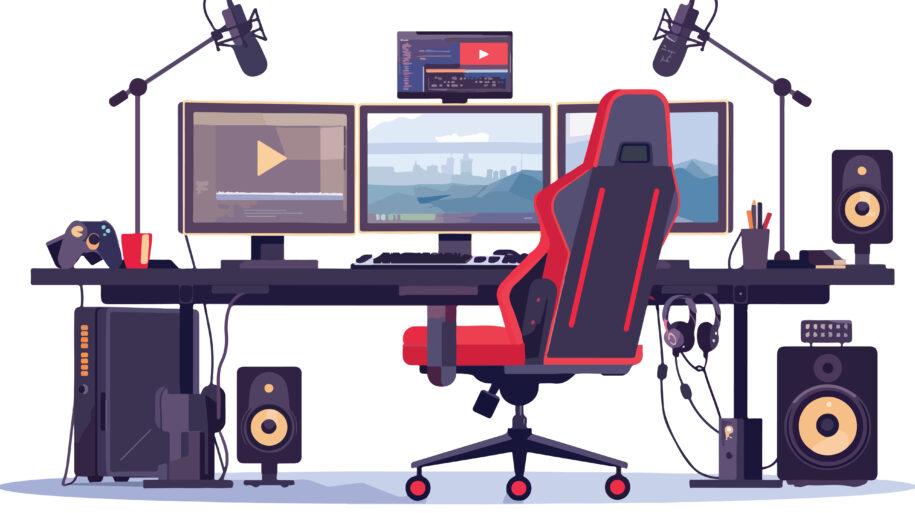
Sometimes more is better. Setting up dual monitors on a gaming PC can significantly enhance your gaming experience and productivity. Having two screens offers a multitude of benefits. This guide will walk you through the process of setting up dual monitors, ensuring you get the most out of your gaming rig.
Table of Contents
Why Use Dual Monitors?
Before diving into how to setup dual monitors, let’s take a look at some of the benefits of dual monitors.
- Increased Field of View: In games that support multiple screens, you can enjoy a wider field of view, making for a more immersive experience.
- Multitasking: Easily manage different applications simultaneously, such as browsing game guides, monitoring stream chats, chatting on discord, or setting up your Spotify playlist.
- Productivity Boost: Outside of gaming, dual monitors are excellent for productivity, allowing you to work on multiple tasks without the need to switch between windows all the time.
What You’ll Need to Set up Dual Monitor
To set up dual monitors on your gaming PC, here’s what you will need.
- Two monitors
- A CyberPower gaming PC with a graphics card that supports dual displays (all modern graphics cards will be able to do this)
- The necessary cables (HDMI, DisplayPort, DVI, or VGA)
- A sturdy desk with room for the extra monitor, a monitor stand or monitor arm
Step-by-Step Guide to Setting Up Dual Monitors
1. Check Your Graphics Card and Ports
First, ensure that your graphics card can support dual monitors. Well if you have a gaming pc with a graphics card, congratulations you can use more than one monitor. Most modern GPUs have multiple types of ports, such as HDMI, DisplayPort, and DVI. Check the back of your PC to see what ports are available and ensure your monitors have compatible inputs.
2. Connect the Monitors
Connect your monitors to the graphics card using the appropriate cables, chances are you will be using HDMI or DisplayPort.
- HDMI: Commonly used and supports both video and audio.
- DisplayPort: Preferred for higher resolutions and refresh rates.
- DVI: Good for older monitors; ensure you have the correct version (DVI-D for digital).
- VGA: Analog and less common, used mainly for older displays.
3. Power On and Configure
Once connected, power on your monitors and your PC. Windows should automatically detect the new monitor.
Windows Steps:
- Right-click on the desktop and select Display settings.
- In the display settings window, you should see both monitors represented. If not, click Detect.
- Select the display arrangement you prefer. You can drag and drop the monitors to match their physical arrangement on your desk.
- Choose the primary display by selecting the monitor you want as your main display and checking Make this my main display.
- Adjust the resolution and orientation if necessary. For gaming, ensure both monitors are set to their optimal resolution and refresh rate.
4. Configure In-Game Settings
For games that support multi-monitor setups, you may need to adjust in-game settings:
- Open the game and go to video or display settings.
- Look for options like multi-monitor setup or extended view.
- Configure the settings to utilize both monitors. This may involve setting the resolution to span across both screens.
- Or keep the game on one monitor, and your other free for whatever you like, the choice is yours!
5. Customize Your Setup
After the basic setup, you can further customize your dual-monitor setup through options available in Windows:
- Wallpapers: Set different wallpapers for each monitor
- Taskbar: In Windows, you can customize the taskbar to appear on one or both monitors.
- Hotkeys: Set up hotkeys for easy window management across monitors.
6. Troubleshooting Tips
If you encounter any issues, here are some steps you can take to troubleshoot:
- Check Cable Connections: Ensure all cables are securely connected.
- Update Drivers: Make sure your graphics card drivers are up to date.
- Monitor Settings: Verify the input source settings on your monitors.
- Re-detect Displays: Go to your display settings and click on Detect if the second monitor is not recognized.
Setting up dual monitors on your gaming PC can significantly enhance your gaming and productivity experience. Once you go with multiple monitors, you will wonder how you ever used just a single monitor. By following the steps outlined in the guide above, you can enjoy a multi-monitor setup. Also same steps apply if you add more than an extra monitor to your gaming setup. You can never go wrong with more screen real estate. Happy multimonitor gaming!
Need to add an extra monitor? Head over to our gear store to browse our selection of monitors available for purchase.